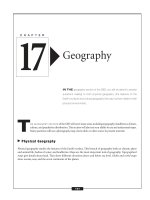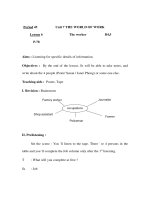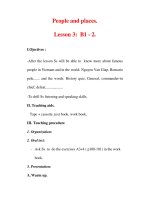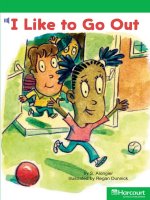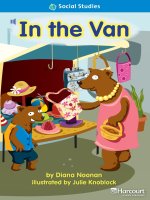3 6 2 chinas gifts to the world (social studies)
Bạn đang xem bản rút gọn của tài liệu. Xem và tải ngay bản đầy đủ của tài liệu tại đây (3.67 MB, 13 trang )
Suggested levels for Guided Reading, DRA,™
Lexile,® and Reading Recovery™ are provided
in the Pearson Scott Foresman Leveling Guide.
China’s Gifts
to the World
Genre
Expository
nonfiction
Comprehension
Skills and Strategy
• Cause and Effect
• Generalize
• Graphic Organizers
Text Features
•
•
•
•
Table of Contents
Captions
Charts
Map
Scott Foresman Reading Street 3.6.2
ISBN 0-328-13402-3
ì<(sk$m)=bdeacb< +^-Ä-U-Ä-U
by Linda Yoshizawa
illustrated by Burgundy Beam
Reader Response
1. Why hasn’t the written Chinese language
changed as much as other languages over
time?
China’s Gifts
to the World
2. What are the “four treasures”? Answer by
completing the web.
FourYoshizawa
Treasures
by The
Linda
illustrated by Burgundy Beam
3. Use a dictionary to find antonyms—words
that mean the opposite—for these
vocabulary words: diverse, flourished,
literate, muffled.
4. Look back at page 19. Explain the
three stages of practice when learning
calligraphy. Why do you think each stage
is important?
Editorial Offices: Glenview, Illinois • Parsippany, New Jersey • New York, New York
Sales Offices: Needham, Massachusetts • Duluth, Georgia • Glenview, Illinois
Coppell, Texas • Ontario, California • Mesa, Arizona
CONTENTS
CHAPTER 1
4
CHAPTER 2
5
CHAPTER 3
7
CHAPTER 4
9
CHAPTER 5
11
CHAPTER 6
17
The Wonders of Asia
The Language of China
Language as Art
The Poet Li Po
The Calligrapher’s Tools
Every effort has been made to secure permission and provide appropriate credit for
photographic material. The publisher deeply regrets any omission and pledges to
correct errors called to its attention in subsequent editions.
Learning Calligraphy
Now Try This
Glossary
20
22
Unless otherwise acknowledged, all photographs are the property of Scott Foresman,
a division of Pearson Education.
ISBN: 0-328-13402-3
Copyright © Pearson Education, Inc.
All Rights Reserved. Printed in the United States of America. This publication is
protected by Copyright, and permission should be obtained from the publisher
prior to any prohibited reproduction, storage in a retrieval system, or transmission
in any form by any means, electronic, mechanical, photocopying, recording, or
likewise. For information regarding permission(s), write to: Permissions Department,
Scott Foresman, 1900 East Lake Avenue, Glenview, Illinois 60025.
2 3 4 5 6 7 8 9 10 V0G1 14 13 12 11 10 09 08 07 06 05
3
Chapter 1
The Wonders of Asia
In the late 1200s, Marco Polo, the
young son of a trader, traveled to the Far
East with his father. For seventeen years,
he journeyed throughout China and the
Far East.
On his journeys, Marco Polo saw many
of the wonders of Asia. He saw precious
jewels, gold-paved streets, beautiful silk
clothing in bright colors, and he tasted
all kinds of wonderful spices. He also
discovered the beautiful Chinese language.
Chapter 2
The Language of China
China’s towering mountains and huge
deserts kept it isolated from Europe for
many years. During those years, Chinese
civilization flourished. The ancient Chinese
knew how to make paper several centuries
before the Europeans. They also knew how
to print with movable type. The ancient
Chinese invented gunpowder—which they
used to make rockets and bombs—and
they invented a system of writing.
By the third century A.D., the Chinese understood
how magnets worked. They used magnets to invent
a compass.
4
5
Today, China is one of the largest and
most populated countries in the world.
With so much land and so many people,
it’s not surprising that the country is so
diverse. People in different parts of China
even speak different dialects, or versions,
of the Chinese language.
No matter what dialect they speak,
literate Chinese can read the same written
language, because the language is written
in pictures called characters instead of
letters. Each picture stands for a word or
an idea. The written language has kept the
people united.
HEART
FISH
GOLD
KNOWLEDGE
FACE
NOSE
Chapter 3
Language as Art
Most languages change over time.
The written language of China has not
changed much over the years, though, and
modern Chinese scholars can easily read
ancient poetry just as it was first written.
No translation is needed!
Literature has always been an
important part of Chinese culture, so it is a
good thing that the literature of the past is
easy for people in China to read today.
In China, literature is important for its
history, ideas, and the beautiful way it is
written. Chinese writing is also known as
calligraphy.
Chinese calligraphers do not use an
alphabet to write individual letters that
form words as we do. Instead, they paint a
character. Each character is a little picture
that stands for one object or idea.
Each small character is a work of art in
itself. Scholars study and practice for many
years to learn how to make each character.
Then, they practice drawing them in their
own individual styles.
Chinese characters
6
7
Even people who do not read Chinese
enjoy looking at the characters drawn
by calligraphers. Examples of the art of
calligraphy appear in museums all around
the world. You could also find examples of
this art hanging on the walls in people’s
homes. To many art lovers, calligraphy is a
much loved and treasured form of fine art.
Chapter 4
The Poet Li Po
From ancient to modern times, China
has had many famous poets, novelists, and
essay writers. One of the best known is the
poet Li Po.
Li Po lived from 701 to 762, during the
Tang Dynasty, a period in Chinese history
when all the arts flourished. He wrote
about everyday ideas. His writing was
happy and light, celebrating the delights
of life.
Li Po’s favorite subjects were nature,
friends, and the joy of spending time
alone. Although he had a family and spent
time living at the emperor’s court, he often
took time off for “wandering.” Perhaps his
journeys gave him the inspiration for his
poems.
A Chinese poem
8
9
Li Po won lasting fame as a poet. Sadly,
though, he failed to achieve one of his
life’s goals: the emperor never gave him
an official title. Disappointed, he joined a
military expedition. The emperor thought
the purpose of the expedition was to
create a new dynasty, and he became
angry. He had the leader of the expedition
killed and he jailed Li Po.
Chapter 5
The Calligrapher’s Tools
Ancient calligraphers used special tools
for writing that they referred to as “the
four treasures.” One treasure was their
collection of special brushes. They also
needed ink sticks and ink stones to make
ink. The fourth treasure was fine paper.
You ask me why I dwell in the green mountain,
I smile and make no reply for my heart is free of care.
As the peach-blossom flows downstream and is gone into the unknown,
I have a world apart that is not among men.
10
11
The first calligraphy brushes were made
at least 4000 years ago. Modern brushes
have not changed much. The bristles are
still made from animal hair attached to
bamboo reeds.
Brushes come in different sizes, and the
bristles have different textures too. Some
are soft, and some are stiff, while others
have a mixture of soft and stiff bristles.
Brush makers use many different kinds
of animal hair. They use hair from goats,
wolves, deer, sheep, and foxes.
12
Ancient calligraphers did not buy ink in
a bottle. They made their own ink, using
an ink stick and an ink stone.
Like other traditional calligraphy
materials, ink sticks have been used for
thousands of years. The basic ingredient
in an ink stick is soot. Soot is the black
substance in smoke that comes after you
burn something. Some ink sticks use soot
from burned pine trees or oil.
The soot is collected and mixed with
other ingredients that hold it together.
Then the sticks are formed and decorated.
Good ink sticks can last as long ten
years. Surprisingly, the best way to
determine an ink stick’s quality is to tap it
and listen to the sound. The sound should
be clear and sharp, not muffled.
13
An ink stick is not like chalk; it is
too hard and solid to write with. After
calligraphers choose the best ink stick, they
need to turn it into ink. To do this, they
need an ink stone.
Calligraphers use ink stones to grind
tiny flakes off the ink stick. Then they mix
the flakes with water to make a liquid.
To make ink, artists start by putting a
little cool water on the stone. Water that
has a small amount of salt works best.
Then they rub the stick in the water. Once
they have made a thick liquid, they add a
little more water and rub some more. They
keep working until the ink is just they way
they want it.
Tips for Making Calligraphy Ink
1. Use the best ink stick you can find.
2. Use water that has a little bit of salt.
If you cannot use saltwater, use well
water, tap water, or bottled distilled
water.
3. Start with a small amount of water.
4. Press the ink stick against the stone
and rub lightly in circles.
5. Grind all the ink for one project at
the same time. It is hard to make two
batches of ink that are exactly the
same color.
6. Don’t make the ink too thick. Thick ink
makes brush bristles stick together.
7. Don’t make the ink too thin. Thin ink
may go right through the paper.
8. Use the ink right away.
Ink stick
and ink stone
14
15
Calligraphers can paint their beautiful
characters on any kind of surface. Some
artists draw on silk; most use special paper.
Artists who want their work to last a
long time use a special kind of paper called
Xuan paper. Some artwork made on Xuan
paper has lasted a thousand years. Xuan
paper does not tear easily and will not be
damaged by insects. Even if the paper gets
wet, the artwork will not be destroyed.
16
Chapter 6
Learning Calligraphy
Calligraphy is not easy to learn. The
Chinese written language has about 50,000
characters. About 7,000 characters are
commonly used. Calligraphers spend years
studying them.
Calligraphy students begin by learning
basic techniques. They learn the right way
to hold the brush. They learn the correct
posture for writing. Then, they learn the
basic brushstrokes.
After that, they practice, practice, and
practice! One great artist named Wang
Xizhi spent lots of time practicing while
he was growing up. After each session, he
cleaned his brushes in the pond outside his
family’s home. Some people say he cleaned
so many brushes that the whole pond
turned black with ink!
17
Even though China has a new system
of alphabetic writing, calligraphy is not a
lost art. Many people still use characters
to communicate. Character writing is still
taught in Chinese schools.
Someday character
Calligraphy is written
writing may become
in lines from the top
less common. But many
of the page to the
people will still want to
bottom, beginning
learn this ancient and
on the right side of
respected art.
the page.
18
Calligraphy is an art form with many
traditions. One tradition is about a special
way to practice. Practice is done in three
stages. The stages are called “mo,” “lin,”
and “xie”.
During the “mo” stage, students
learn to practice using a brush to make
basic strokes. Then students move on to
the “lin” stage. In this stage, they copy
a model. Students copy the model onto
paper filled with squares.
The “xie” stage is the time for students
to write on their own. They begin to write
their own thoughts.
In the “xie” stage, students also
develop their own style. Everyone’s
handwriting looks a little different, and
calligraphy, after all, is an art!
19
Now Try This
to Do It!
w
o
H
s
’
e
r
He
Be a Calligrapher
Try some calligraphy yourself. Since
you are a beginner, you won’t use special
calligraphy tools. Instead, use a simple
paint brush with a fine point and some
tempera paint. You can paint on regular
art paper.
1. Gather the materials you’ll need.
2. Practice using the inked paint
brush to make different kinds of
brushstrokes on the paper.
3. Choose a character from the chart
to copy.
4. Study the lines in the character.
friend
5. Trace over the lines with your
finger and decide how to form the
brushstrokes.
6. Practice! Practice! Practice!
school
dog
sun
laugh
20
21
Glossary
bristles n. the hairs
on a brush
dialects n. different
versions of a
particular language
diverse adj. different
expedition n. a
journey with a
specific purpose
flourished v. steadily
grew; expanded
ingredient n. one of
several substances
mixed together
to make a new
substance
inspiration n.
something that
stimulates a person
to be creative
22
Reader Response
literate adj. having
the ability to read
and write
1. Why hasn’t the written Chinese language
changed as much as other languages over
time?
muffled adj.
unable to be heard;
wrapped with
material to deaden
the sound
2. What are the “four treasures”? Answer by
completing the web.
techniques n.
methods of doing
something
translation n.
message or text
changed from one
language into a
different language
The Four Treasures
3. Use a dictionary to find antonyms—words
that mean the opposite—for these
vocabulary words: diverse, flourished,
literate, muffled.
4. Look back at page 19. Explain the
three stages of practice when learning
calligraphy. Why do you think each stage
is important?

